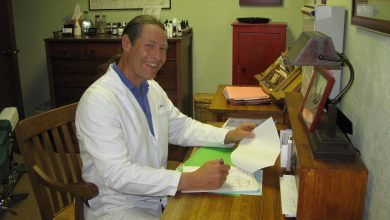Dr. Ed Warr – Today’s Dentistry
 If you have been told you have periodontal (gum) disease, you’re not alone. One half of adults in the U.S. currently have some form of the disease. Periodontal disease ranges from inflammation in the gums to serious damage in the soft tissue and bone around teeth, resulting in tooth loss. Research has shown that periodontal disease may also be associated with heart disease, pre-term, low birth weight babies, diabetes, and erectile dysfunction. Traditional treatment has ranged from “deep cleanings” to cutting off gum tissues. PerioLase LANAP treatment gently cleans diseased areas and enables new connective tissue to re-attach to the tooth. It is the ONLY laser with clinical evidence and FDA approval supporting this. I spoke with Dr. Ed Warr about PerioLase LANAP treatment to learn how it works and the benefits it achieves.
If you have been told you have periodontal (gum) disease, you’re not alone. One half of adults in the U.S. currently have some form of the disease. Periodontal disease ranges from inflammation in the gums to serious damage in the soft tissue and bone around teeth, resulting in tooth loss. Research has shown that periodontal disease may also be associated with heart disease, pre-term, low birth weight babies, diabetes, and erectile dysfunction. Traditional treatment has ranged from “deep cleanings” to cutting off gum tissues. PerioLase LANAP treatment gently cleans diseased areas and enables new connective tissue to re-attach to the tooth. It is the ONLY laser with clinical evidence and FDA approval supporting this. I spoke with Dr. Ed Warr about PerioLase LANAP treatment to learn how it works and the benefits it achieves.
Dr. Warr, thanks for talking with me today. Can you start off by telling us what periodontal disease is?
Periodontal disease is a chronic, bacteria-induced inflammatory condition that destroys the bone and ligaments around teeth. It is the number one cause of tooth loss and may also be associated with pre-term, low birth weight babies, diabetes, heart disease, various cancers, and erectile dysfunction.
Are patients typically aware if they have periodontal disease?
No. In that sense it is similar to heart disease. Physicians describe heart disease as a silent killer because a person typically doesn’t feel anything until tightness in the chest or a heart attack occurs. Periodontal disease is the same way – people don’t take note of the symptoms until major problems have developed.
What are some common signs and symptoms of the disease?
The earliest signs and symptoms are bleeding gums, puffiness in the gums, and maybe a feeling of slight irritation in the gums. Unfortunately, most people ignore this and wait until they are experiencing bad breath, changes in their bite, and moving or shifting teeth. At this point in the disease progression, there has already been extensive damage to the tissues that support the teeth.
What is the average age for this happening to people?
Periodontal disease typically begins afflicting people in their 30s and 40s and then continues throughout the remainder of their lives. Teenagers and young adults can develop the disease, but it is uncommon.
Having an infection in one’s mouth must also affect one’s overall health and wellness.
Yes, yes it does. When gum tissues become inflamed, they are very delicate and bleed easily. All of the tiny blood capillaries are exposed to the oral environment and, most importantly, to the bacteria that are present. These bacteria can enter the bloodstream and travel throughout the body. For example, bacteria associated with periodontal disease have been found on heart valves and in the plaques that develop inside coronary blood vessels. Periodontal disease also activates the immune system. Because it is a bacterial infection the body mounts an immune response against it. It is a chronic infection and so the immune response is constant, creating a drain on the body’s resources.
What is the PerioLase and how does it treat this disease?
The PerioLase MVP-7 is a laser specifically designed to treat periodontal disease. It is used in the Laser Assisted New Attachment Procedure (LANAP). In LANAP, the PerioLase selectively removes diseased tissues and kills bacteria, creating an environment conducive to healing. Then, it creates a seal around the tooth to keep out bacteria, food debris, saliva, and epithelium. It is important to keep epithelium out because it grows 7.5 times faster than connective tissue (cementum, ligament, bone).
 So, to recap, you are saying that skin inside your mouth grows at different rates and that other lasers, in spite of the short-term improvement they achieve, do not encourage the proper tooth supporting tissues (cementum, ligament, bone) to grow back around your teeth?
So, to recap, you are saying that skin inside your mouth grows at different rates and that other lasers, in spite of the short-term improvement they achieve, do not encourage the proper tooth supporting tissues (cementum, ligament, bone) to grow back around your teeth?
That’s right. When a periodontal “pocket” develops, it destroys the natural attachment of ligament to the tooth. The ligament connects to a special coating on the root surface called cementum and to bone. This bone – ligament – cementum provides a robust, durable attachment, anchoring the tooth in place. When “skin”, or epithelium, grows down into the pocket (and it grows 7.5 times faster than these other tissues), it can form an attachment to the root surface as well. However, this epithelium – root attachment is delicate and much more sensitive to environmental factors (plaque, bacteria, food debris, acids, etc.). PerioLase LANAP is the ONLY laser protocol that has demonstrated bone – ligament – cementum type attachment as a treatment outcome.
Why is the PerioLase different than other laser treatments that might be available?
Different lasers use different wavelengths. Different tissues absorb different wavelengths. When a tissue absorbs laser energy it creates a change in that tissue. If the laser passes through a given tissue and is not absorbed, it does not have an effect on that tissue. PerioLase and LANAP provide the FIRST and ONLY FDA approved procedure resulting in “cementum mediated new periodontal ligament attachment to the root surface in the absence of long junctional epithelium.” No other laser can accomplish what the PerioLase and LANAP can.
Dr. Warr, can this treatment be used with individuals who just have a mild case of periodontal disease?
Absolutely! We talked earlier about bacteria and periodontal disease. Bacteria are everywhere. When periodontal disease develops we see high concentrations of bacteria in the diseased sites. There are also lower concentrations of the bacteria throughout the mouth. Through a phenomenon called QUORUM SENSING bacteria communicate with each other to organize their attack. The earlier we have an opportunity to kill these bacterial pathogens, the less damage they cause in someone’s mouth.
What about working on patients with health concerns, i.e., diabetes, heart conditions requiring blood thinners, etc.? Is this safe?
It is safe. Because of the minimally invasive nature of LANAP treatment, there are minimal disruptions to a patient’s well-being. For example, a diabetic will typically have a compromised ability to heal following a surgical procedure. LANAP involves no cutting and no suturing. It forms a seal over the area that closes it off to the rest of the mouth, keeping problems out and promoting healing within. The body, even with diabetes, is better able to recover from this because it provides optimal healing conditions.
 You are very excited to be able to provide this to your patients. Can you say more about this?
You are very excited to be able to provide this to your patients. Can you say more about this?
Traditional treatment options for periodontal disease include doing nothing, scaling and root planning, and resective surgery. None of these options is very exciting for a provider or a patient. Do nothing – we all recognize the problem here. Scaling and root planing simply cleans the pocket, but provides no means for long-term pocket reduction. Consequently, it is done over and over and over without much improvement. Resective surgery means we are cutting off the gums. If a pocket is 9mm deep, we cut away 5-6mm of gum tissue to make a 3-4mm deep pocket. LANAP is effective at reducing pocket depth by creating new, robust connective tissue attachment to the tooth. And it does this with no cutting, no sewing, minimal discomfort, and a faster recovery time. How could I not be excited to help patients!
So this really sounds like Dental Magic.
Well, magic is really only science that we do not yet understand. We should understand that LANAP is not 100% successful. There are factors that can compromise its success (i.e., smoking, non-compliance, and traumatic bite forces). That being said, LANAP utilizes highly specific laser energy and its human tissue interactions to create predictable healing that we have struggled to achieve without it.
What does a typical case study sound like? Can a patient go from having very loose teeth to actually being able to save these teeth and have more stability and strength?
A typical case is hard – each case is as unique as each individual. To use your question of someone suffering from loose teeth – often times this is when they first realize they have a problem. Their bite begins to change or they notice that their teeth are moving and shifting and they are wondering why. At this point, we will typically see 7-10mm pockets around the teeth involved. LANAP therapy has demonstrated predictable reduction in pocket depths around teeth like this by regenerating the natural bone – ligament – cementum attachment to the teeth. Teeth become stable again, patients are able to chew, and they feel much better overall because the infection around their teeth is gone.
How do you typically work on patients?
Most people will have significant periodontal disease that involves the majority of their teeth. In these cases we will work on one side of the mouth first (left, for example), then, one to two weeks later work on the other side. During the appointment, the area around each tooth will be treated with the PerioLase, a seal will be created, and the bite will be adjusted to remove any traumatic bite forces that would interfere with healing. There will be several follow up appointments over the course of a year. At the end of one year, LANAP is considered complete and an appropriate maintenance interval is recommended for each patient.
 How can our patients learn more and when will you begin offering this service?
How can our patients learn more and when will you begin offering this service?
Our website, www.AshlandDentist.com is an excellent resource. It contains more detailed descriptions of the PerioLase laser, the LANAP treatment, case examples, and video segments. We are already offering the procedure. For those who would like to learn more, they can mention this interview and receive a complimentary consultation.
Dr. Warr are there any final comments you would like to make; any hopes or expectations about your new PerioLase and the LANAP treatment?
My hope is to teach people about LANAP and restore their hope in a healthy mouth and keeping their teeth. Several months ago I had referred a patient to a periodontist because her periodontal disease was so severe. She came into my office a couple of weeks ago, just after I had completed my PerioLase and LANAP training. It was at the end of the day and she wanted to know if she really needed to go to the periodontist. We talked for 45 minutes about PerioLase and LANAP therapy. It was wonderful to see her fear about treatment be replaced by the hope of being able to save her teeth. I am very excited for what I will be able to do for my patients with periodontal disease!
Learn More:
Today’s Dentistry
1530 Siskiyou Blvd. Ashland
541-482-7771
www.ashlanddentist.com




